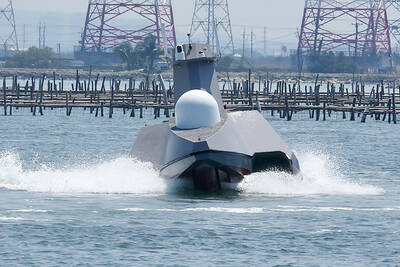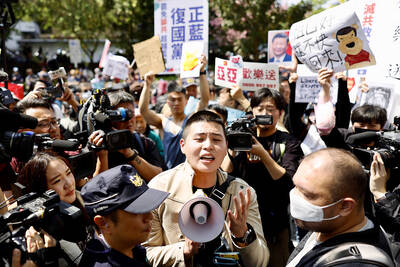In a major report scheduled to be released yesterday, a US congressional commission urges US President Barack Obama to encourage China to “demonstrate the sincerity of its desire for improved cross-strait relations by drawing down the number of forces, including missiles, opposite Taiwan.”
The US-China Economic and Security Review Commission report also recommends that Congress encourage Obama to strengthen bilateral economic relations between the US and Taiwan and work with Taipei to modernize its armed forces, with particular emphasis on its air defense needs.
Coming at the end of Obama’s first Asian tour, the 367-page report from the commission — a bipartisan group established in 2000 to investigate, analyze and provide recommendations to Congress — could strengthen support for Taiwan on Capitol Hill.
It may have little impact in the White House, however, where — according to some political analysts — the Obama administration appears reluctant to do anything that could upset Beijing.
In a 13-page section on Taiwan, the report says that despite apparent progress in cross-strait relations, Beijing has shown no signs of stemming its buildup of military capacities vis-a-vis Taiwan “increasing the disparity between China and Taiwan’s respective military capabilities.”
It reveals that a study done for the commission by the Science Applications International Corp found that China’s military had become a “clear and present threat” to Taiwan’s autonomy because of significant improvements in its missile, air and naval capabilities.
“In the event of a military conflict between China and Taiwan, one possible option that the PLA [People’s Liberation Army] could employ is a missile saturation campaign in order to soften the island’s defenses,” the report says.
“The PLA has a large inventory of ballistic and cruise missiles, as well as anti-radiation attack drones — used to knock out radar installations — at its disposal for such a campaign,” the report says.
“China’s 1,100-plus short-range ballistic missiles targeting Taiwan are sufficiently accurate to pose a serious threat to a wide range of immobile targets on the island, such as command and control facilities, air defense nodes, air bases, naval bases and political targets,” it says.
The report says that the PLA would also likely use ground and air-launched land-attack cruise missiles to hit hard-to-strike high-value assets while anti-radiation attack drones would target hidden air defense radars.
It says Taiwan’s “limited missile defenses” would be incapable of providing sustained protection and would likely be exhausted quickly.
“Taiwanese cruise missiles could be used to strike mainland missile repositories, command and control facilities and possibly even air bases or ports,” the report says.
“Taiwanese aircraft are capable of attacking the mainland. However, the Taiwanese military is likely to conserve these for air defense purposes instead,” it says.
After initial attacks, the report forecasts, the PLA could be expected to launch a campaign to seize air superiority.
“The success of seizing air superiority is critical in determining the outcome of any large-scale use of force against Taiwan,” the report says.
“Over the years, Taiwan’s air capabilities relative to China’s have begun to shrink. In contrast to the growing size and quality of the PLA’s fighter force, Taiwan has not substantially upgraded its fighter force in the past decade and may not do so in the near future,” it says.
The report notes that although Taiwan wants to buy 66 F-16C/D fighters from the US, “it is unclear whether the Obama administration will agree to sell these or other modern aircraft to Taiwan.”
The report says the central focus of China’s naval modernization efforts since the 1990s has been to deter Taiwanese independence.
“Taiwan’s independence ultimately challenges the Chinese Communist Party’s [CCP] continued rule in Beijing, because the CCP has partially staked its legitimacy on reunification with Taiwan,” the report says.
Taiwan’s continued de facto independence, the report says, hinders China’s emergence as a regional power since it would limit the PLA’s strategic space.
“For Beijing, a key component of ensuring that Taiwan does not declare independence requires deterring, denying or delaying the United States from intervening on Taiwan’s behalf,” the report concludes.
“Rear Admiral Michael McDevitt testified to the commission that China aims to keep an approaching force from closing to within striking range of the Chinese mainland and the Taiwan Strait — a sentiment echoed by several experts,” it says.
“Cortez Cooper, a senior international policy analyst at the RAND Corporation, stated that a goal of China’s naval modernization is to vastly improve the capability to hold US naval formations at risk in the Western Pacific and to delay or deny their entry into a Taiwan theater of operations,” it says.

ENDEAVOR MANTA: The ship is programmed to automatically return to its designated home port and would self-destruct if seized by another party The Endeavor Manta, Taiwan’s first military-specification uncrewed surface vehicle (USV) tailor-made to operate in the Taiwan Strait in a bid to bolster the nation’s asymmetric combat capabilities made its first appearance at Kaohsiung’s Singda Harbor yesterday. Taking inspiration from Ukraine’s navy, which is using USVs to force Russia’s Black Sea fleet to take shelter within its own ports, CSBC Taiwan (台灣國際造船) established a research and development unit on USVs last year, CSBC chairman Huang Cheng-hung (黃正弘) said. With the exception of the satellite guidance system and the outboard motors — which were purchased from foreign companies that were not affiliated with Chinese-funded

PERMIT REVOKED: The influencer at a news conference said the National Immigration Agency was infringing on human rights and persecuting Chinese spouses Chinese influencer “Yaya in Taiwan” (亞亞在台灣) yesterday evening voluntarily left Taiwan, despite saying yesterday morning that she had “no intention” of leaving after her residence permit was revoked over her comments on Taiwan being “unified” with China by military force. The Ministry of the Interior yesterday had said that it could forcibly deport the influencer at midnight, but was considering taking a more flexible approach and beginning procedures this morning. The influencer, whose given name is Liu Zhenya (劉振亞), departed on a 8:45pm flight from Taipei International Airport (Songshan airport) to Fuzhou, China. Liu held a news conference at the airport at 7pm,

AIR SUPPORT: The Ministry of National Defense thanked the US for the delivery, adding that it was an indicator of the White House’s commitment to the Taiwan Relations Act Deputy Minister of National Defense Po Horng-huei (柏鴻輝) and Representative to the US Alexander Yui on Friday attended a delivery ceremony for the first of Taiwan’s long-awaited 66 F-16C/D Block 70 jets at a Lockheed Martin Corp factory in Greenville, South Carolina. “We are so proud to be the global home of the F-16 and to support Taiwan’s air defense capabilities,” US Representative William Timmons wrote on X, alongside a photograph of Taiwanese and US officials at the event. The F-16C/D Block 70 jets Taiwan ordered have the same capabilities as aircraft that had been upgraded to F-16Vs. The batch of Lockheed Martin

GRIDLOCK: The National Fire Agency’s Special Search and Rescue team is on standby to travel to the countries to help out with the rescue effort A powerful earthquake rocked Myanmar and neighboring Thailand yesterday, killing at least three people in Bangkok and burying dozens when a high-rise building under construction collapsed. Footage shared on social media from Myanmar’s second-largest city showed widespread destruction, raising fears that many were trapped under the rubble or killed. The magnitude 7.7 earthquake, with an epicenter near Mandalay in Myanmar, struck at midday and was followed by a strong magnitude 6.4 aftershock. The extent of death, injury and destruction — especially in Myanmar, which is embroiled in a civil war and where information is tightly controlled at the best of times —